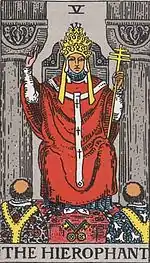The Hierophant
The Hierophant (V), in some decks named The Pope, is the fifth trump or Major Arcana card in most traditional Tarot decks. It is used in game playing as well as in divination.

Description and symbolism
In many modern packs, the Hierophant is represented with his right hand raised in blessing or benediction, with two fingers pointing skyward and two pointing down, thus forming a bridge between Heaven and Earth reminiscent of that formed by the body of The Hanged Man. The Hierophant is thus a true "pontiff", in that he is the builder of the bridge between deity and humanity. In his left hand he held a triple cross. The Hierophant is typically male, even in decks that take a feminist view of the Tarot, such as the Motherpeace Tarot, The Hierophant was also known as "The Teacher of Wisdom".
In most iconographic depictions, the Hierophant is seen seated on a throne between two pillars symbolizing Law and Liberty or obedience and disobedience, according to different interpretations. He wears a triple crown, and the keys to Heaven are at his feet. Sometimes he is shown with worshippers, as his alternate title is the Pope or, sometimes, Jupiter.[1] The card is also known as "The High Priest", as a counterpart to "The High Priestess" (which itself is also sometimes known as "The Papess", as counterpart to "The Pope").
History
The papacy was not just a religious force, but was a political and military force as well. When the tarot was invented, the Pope controlled a large portion of central Italy known as the Papal States. Renaissance culture did not question the abstract ideal of the Pope as God's human representative on Earth, but others involved in the religious Reformation of that Age would have completely disagreed. In Tarot of Marseilles, he wears a red cape and a blue robe, in contrast to The Papess, who wears a blue cape and blue robe.
The more commonly encountered modern name "Hierophant" is due to Antoine Court de Gébelin. According to de Gebelin, "hierophant" was the title of the chief priest in the Eleusinian mysteries (an ancient Greek ritual).
Interpretation
According to A.E. Waite's Pictorial Key to the Tarot, the Hierophant card carries several divinatory associations:[2]
5. THE HIEROPHANT.--Marriage, alliance, captivity, servitude; by another account, mercy, and goodness; inspiration; the man to whom the Querent has recourse. Reversed: Society, good understanding, concord, over kindness, weakness.
References
- Dummett, Michael and Ronald Decker. History of the Occult Tarot. Duckworth, 2002.
- Waite, Arthur Edward, 1857-1942. (2005). The pictorial key to the tarot (PDF). Mineola, NY: Dover Publications. ISBN 0-486-44255-1. OCLC 57549699.CS1 maint: multiple names: authors list (link)
External links
| Wikimedia Commons has media related to Pope (Major Arcana). |
- The History of the Hierophant (Pope) Card from The Hermitage.